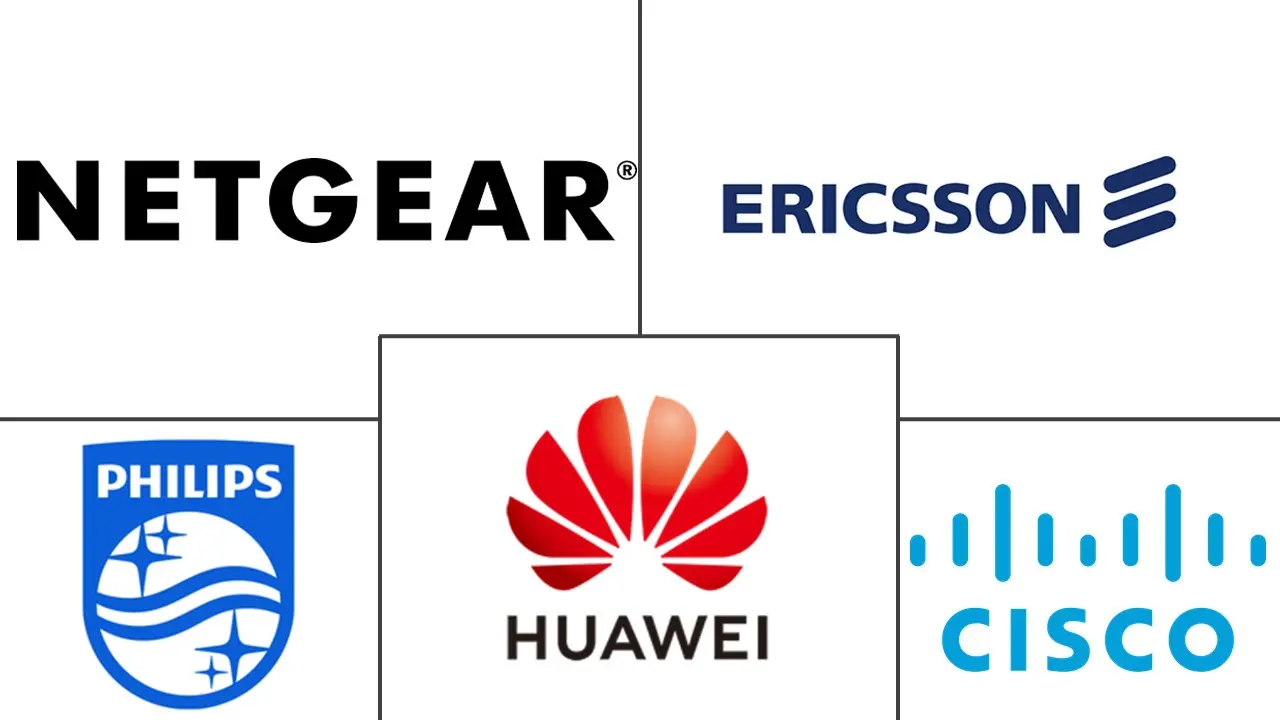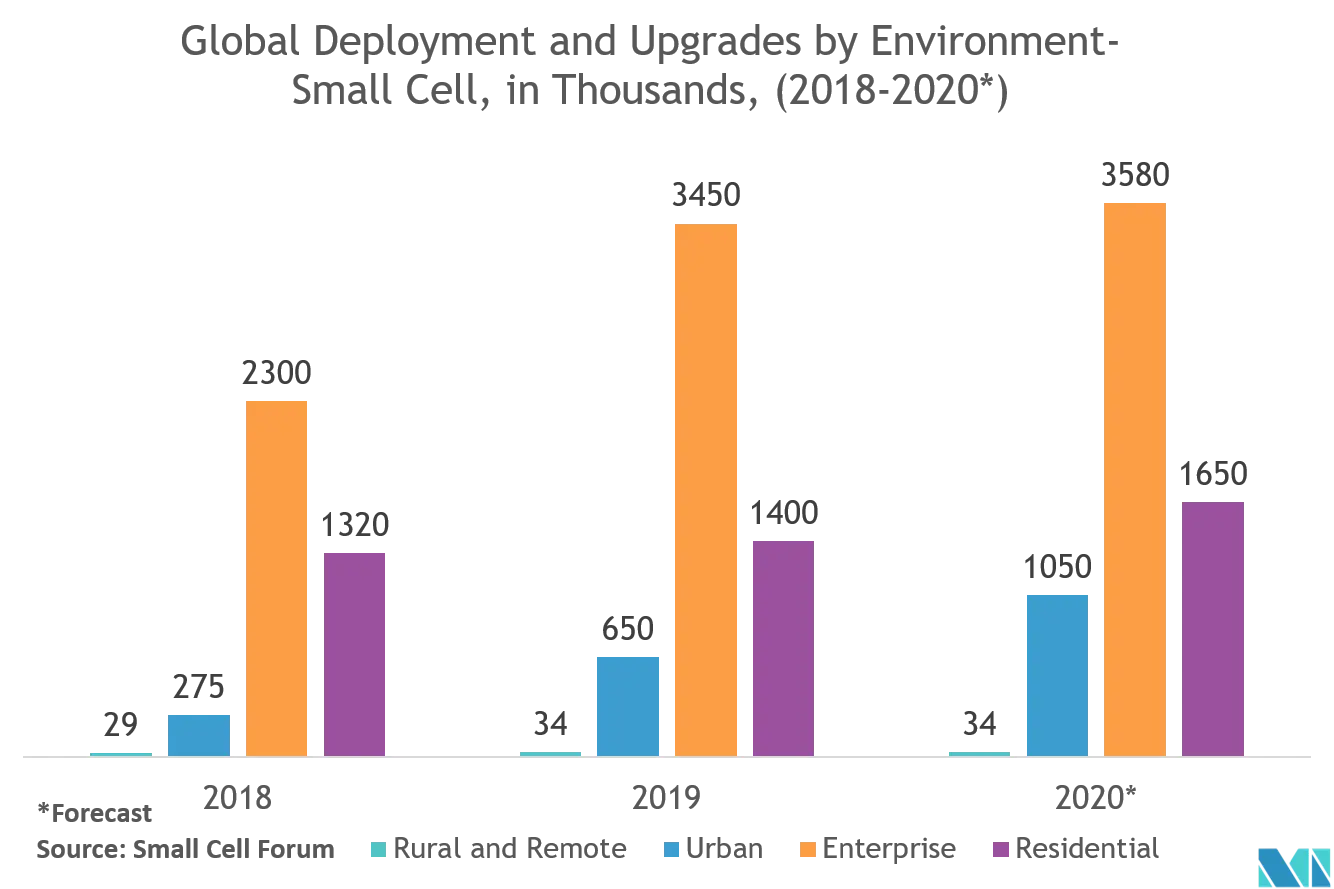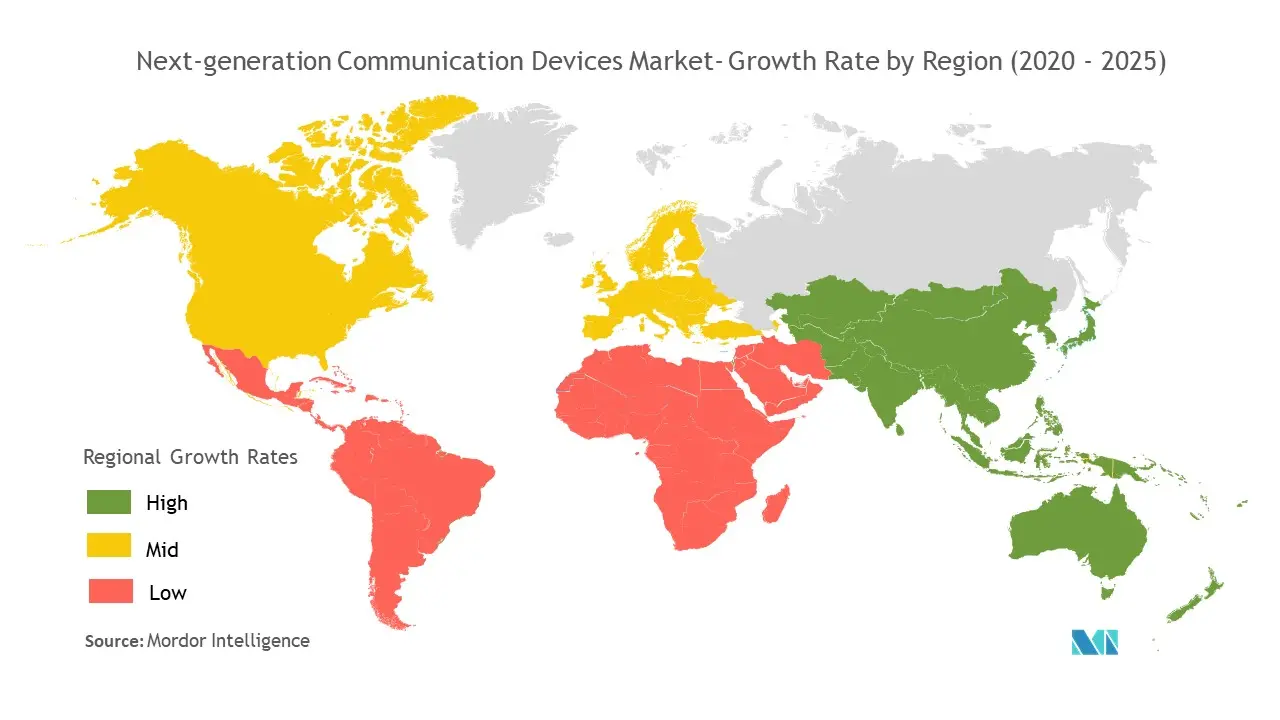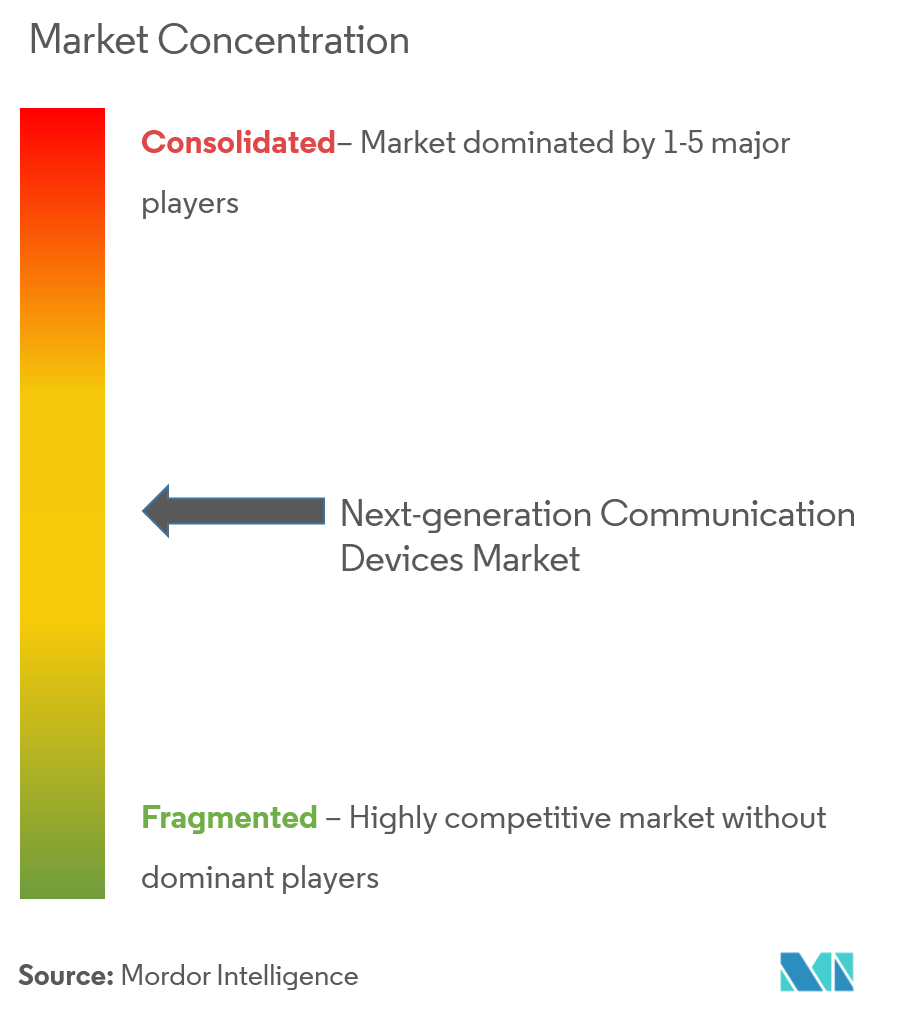Next-generation Communication Devices Market Size

| Study Period | 2019 - 2029 |
| Base Year For Estimation | 2023 |
| CAGR | 20.00 % |
| Fastest Growing Market | Asia Pacific |
| Largest Market | North America |
| Market Concentration | Medium |
Major Players
*Disclaimer: Major Players sorted in no particular order |
Need a report that reflects how COVID-19 has impacted this market and its growth?
Next-generation Communication Devices Market Analysis
The next-generation communication devices market is expected to register a CAGR of over 20% during the forecast period, 2021-2026. The advent of IoT, Industrial 4.0, coupled with increasing technological and automation investments, are demanding more efficient networks. Technologies that address these needs, including asset monitoring, security, transportation, etc., are driving the market for next-generation communication, such as 5G, Li-Fi, wireless sensors network (WSN), etc. driving the for next-generation communication devices market.
- Technolgies such as Visible Light Communication(VLC)/Li-Fi technology enables data transmission via light rather than radio waves at high-speeds through small adjustments in the intensity. The result is a high-speed Internet connection that is more secure, reliable, and able to deliver bandwidth far beyond the capabilities of conventional wireless communications such as Wi-Fi. Thereby, they have huge potential in applications such as military where security and reliability are paramount to their importance. However, the market for Li-Fi is currently in the nascent stage with very few publicly listed companies investing in the technology, with startups are making their way into the market.
- The substantial investments in the industry are expected to develop new sensor technologies, and upgrading existing infrastructure to support IoT and automation have been the primary trends impacting the industry on a global scale.
- Industries, such as oil and gas, waste management, and automotive manufacturing, are the major end-users of industrial WSNs. However, smaller industries, such as the cold storage, are likely to adopt WSNs for enhanced productivity and expected to generate a high demand for WSNs during the forecast period. This is expected to influence the market over the forecast period.
- Overall, the market for next-generation communication depends on infrastructural investments and use cases, which have started accelerating in recent years. Over the forecast period, these technologies are expected to revolutionize communication and led by companies, such as Cisco, Huawei, Ericsson, etc., with the support of telecom providers.
- The year 2020 was predicted to be the year when 5G goes mainstream. Yet, due to the spread of novel coronavirus, 5G rollout in several markets will be delayed further, and its services will be the hardest hit. However, according to ASSIA Inc., there is an 80% increase in PC/phone upload traffic since the beginning of March in the United States, with webcams, laptops, and PCs running video streams all the time. Wi-Fi networks are uploading huge data amounts of data, and a lot of teleconferencing, online education, and even telemedicine applications are not working properly due to network problems. In such instances of high network demand, the prevailing situation of the COVID-19 outbreak could fuel the market's growth.
Next-generation Communication Devices Market Trends
This section covers the major market trends shaping the Next-generation Communication Devices Market according to our research experts:
5G Technology is Expected to Hold a Significant Share
- The growing mobile data traffic is augmenting the market's growth positively. According to the Cisco Visual Networking Index (VNI) Global Mobile Data Traffic Forecast, Mobile data traffic is expected to witness a CAGR of 46% from 2017 to 2022, reaching 77.5 exabytes per month by 2022. Additionally, Cisco's study also states that by 2022, a 5G connection will generate 2.6 times more traffic than the average 4G connection. By the deployment of the 5G, the rising data usage will meet the efficient network quality required.
- With the increasing demand for networks, companies are creating new approaches to 5G deployments. They have the potential to make small cells more affordable and attractive for both MNOs and vertical enterprises. Additionally, NFV and SDNs are the simplified and virtualized network options providing building blocks for enhanced capabilities through function centralization.
- In today's environment, small cells are required for the applications in need of increased bandwidth as well as the increasing number of connected devices. For instance, According to Cisco Systems Inc., 500 billion devices are expected to be connected to the internet by 2030. Moreover, 5G telecom operators are focused on deploying small cell under low-frequency band for offering enhanced bandwidth services to the customer.
- Additionally, the evolution of RAN for 5G is expected to have a huge impact on wireless technologies, including enabling Mobile Edge Computing (MEC) and network slicing. These RANs of the future will also contribute to the lower latency that would make 5G powerful. Various partnerships are being witnessed in this domain. For instance, in June 2020, Ericsson announced that it was the preferred vendor for 5G by Canadian telco, Bell. Ericsson will supply kit for the Radio Access Network (RAN) of Bell's non-standalone 5G network.

North America to Account for a Major Share
- As per Ericsson, North America is expected to lead the 5G mobile technology with major operators stating their intentions to deploy 5G. By 2023, around 50% of all mobile subscriptions in the region are forecasted for 5G. The US federal government is also planning to build a centralized 5G wireless network across the country by 2021.
- With the increasing 5G network rollouts, smartphone OEMs and telecom players in the region are rapidly gearing toward the shift. Smartphone component vendors such as Qualcomm Technolgies Inc are developing 5G modem chipsets in combination with service providers. For instance, In June 2020, the company launched the new Snapdragon 690, the first 5G - enabled mobile platform in the Snapdragon 6 series
- Moreover, the surge in demand for advanced technologies, such as machine-to-machine communication, connected cars, and AI, is highest in the region as compared to others. Hence it is anticipated to offer ample opportunities for next-generation communication devices market.
- The region is also considered one of the most prominent markets for VLC technology, due to increasing R&D investments in this technology. In 2018, Space and Naval Warfare Systems Command (SPAWAR) of the United States worked with the John Hopkins University Applied Physics Laboratory to evaluate the visible light communication technology, Li-Fi.

Next-generation Communication Devices Industry Overview
The next-generation communication devices market is competitive and consists of several major players. Many companies are increasing their market presence by introducing new products, expanding their operations, entering into strategic partnerships, etc.
- February 2020: Qualcomm Technologies Inc. partnered with Corning Inc to develop 5G mmWave infrastructure systems for enterprises and public venues and accelerate inbuilding 5G deployment. The 5G systems are designed to combine Qualcomm's 5G and mmWave technology expertise with Corning's small cell expertise to deliver affordable and easy-to-install 5G-ready indoor networks.
- February 2019: Marvell Technology Group Ltd and Samsung corporation announced the expansion of their strategic partnership for 5G global infrastructure. Both companies are collaborating on the development and launch of multiple generations of radio and control plane processors for LTE and 5G NR.
Next-generation Communication Devices Market Leaders
-
Huawei Technologies Co. Ltd.
-
Cisco Systems Inc.
-
Netgear Inc.
-
Telefonaktiebolaget LM Ericsson
-
Koninklijke Philips NV
*Disclaimer: Major Players sorted in no particular order

Next-generation Communication Devices Market Report - Table of Contents
1. INTRODUCTION
- 1.1 Study Assumptions and Market Definition
- 1.2 Scope of the Study
2. RESEARCH METHODOLOGY
3. EXECUTIVE SUMMARY
4. MARKET DYNAMICS
- 4.1 Market Overview (includes impact of COVID-19 on the market)
- 4.2 Industry Value Chain Analysis
-
4.3 Industry Attractiveness - Porter's Five Force Analysis
- 4.3.1 Bargaining Power of Suppliers
- 4.3.2 Bargaining Power of Consumers
- 4.3.3 Threat of New Entrants
- 4.3.4 Threat of Substitutes
- 4.3.5 Intensity of Competitive Rivalry
-
4.4 Market Drivers
- 4.4.1 Rising Demand for High-speed Network
- 4.4.2 Growing Machine-to-Machine/IoT Connections
-
4.5 Market Restraints
- 4.5.1 High Infrastructural and Development Cost
5. MARKET SEGMENTATION
-
5.1 Technology
- 5.1.1 5G
- 5.1.2 Visible Light Communication / Li-Fi
- 5.1.3 Wireless Sensor Networks (WSN)
- 5.1.4 Other Technologies
-
5.2 End User Industry
- 5.2.1 Manufacturing
- 5.2.2 Military and Defense
- 5.2.3 Automotive
- 5.2.4 Other End Users Industries
-
5.3 Geography
- 5.3.1 North America
- 5.3.2 Asia Pacific
- 5.3.3 Europe
- 5.3.4 Rest of the world
6. COMPETITIVE LANDSCAPE
-
6.1 Company Profiles
- 6.1.1 Huawei Technologies Co. Ltd
- 6.1.2 Cisco Systems Inc.
- 6.1.3 Analong Devices Inc.
- 6.1.4 Telefonaktiebolaget LM Ericsson
- 6.1.5 Honeywell International Inc.
- 6.1.6 Northrop Grumman Corporation
- 6.1.7 Netgear Inc.
- 6.1.8 Koninklijke Philips NV
- 6.1.9 Panasonic Corp.
- 6.1.10 Purelifi Ltd
- 6.1.11 Laser Light Global
- 6.1.12 Qualcomm Technologies Inc
- *List Not Exhaustive
7. INVESTMENT ANALYSIS
8. FUTURE OF THE MARKET
** Subject To AvailablityNext-generation Communication Devices Industry Segmentation
The next-generation communication technologies refer to convergence infrastructure capable of offering a multitude of services, such as video, data, and voice, at a higher speed than conventional communication technologies. The market scope is limited to the infrastructure-enabling network technologies, such as 5G, Li-Fi, and wireless sensor networks.
| Technology | 5G |
| Visible Light Communication / Li-Fi | |
| Wireless Sensor Networks (WSN) | |
| Other Technologies | |
| End User Industry | Manufacturing |
| Military and Defense | |
| Automotive | |
| Other End Users Industries | |
| Geography | North America |
| Asia Pacific | |
| Europe | |
| Rest of the world |
Next-generation Communication Devices Market Research FAQs
What is the current Next-generation Communication Devices Market size?
The Next-generation Communication Devices Market is projected to register a CAGR of 20% during the forecast period (2024-2029)
Who are the key players in Next-generation Communication Devices Market?
Huawei Technologies Co. Ltd., Cisco Systems Inc., Netgear Inc., Telefonaktiebolaget LM Ericsson and Koninklijke Philips NV are the major companies operating in the Next-generation Communication Devices Market.
Which is the fastest growing region in Next-generation Communication Devices Market?
Asia Pacific is estimated to grow at the highest CAGR over the forecast period (2024-2029).
Which region has the biggest share in Next-generation Communication Devices Market?
In 2024, the North America accounts for the largest market share in Next-generation Communication Devices Market.
What years does this Next-generation Communication Devices Market cover?
The report covers the Next-generation Communication Devices Market historical market size for years: 2019, 2020, 2021, 2022 and 2023. The report also forecasts the Next-generation Communication Devices Market size for years: 2024, 2025, 2026, 2027, 2028 and 2029.
Next-generation Communication Devices Industry Report
Statistics for the 2024 Next-generation Communication Devices market share, size and revenue growth rate, created by Mordor Intelligence™ Industry Reports. Next-generation Communication Devices analysis includes a market forecast outlook to 2029 and historical overview. Get a sample of this industry analysis as a free report PDF download.

